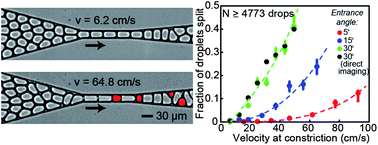Break-up of droplets in a concentrated emulsion flowing through a narrow constriction†
Abstract
This paper describes the break-up of droplets in a concentrated emulsion during its flow as a 2D monolayer in a microchannel consisting of a narrow constriction. Analysis of the behavior of a large number of drops (N > 4000) shows that the number of break-ups increases with increasing flow rate, entrance angle to the constriction, and size of the drops relative to the width of the constriction. As single drops do not break at the highest flow rate used in the system, break-ups arise primarily from droplet–droplet interactions. Analysis of droplet properties at a high temporal resolution of 10 microseconds makes it possible to relate droplet deformation with droplet break-up probability. Similar to previous studies on single drops, no break-up is observed below a set of critical flow rates and droplet deformations. Unlike previous studies, however, not all drops undergo break-up above the critical values. Instead, the probability of droplet break-up increases with flow rate and the deformation of the drops. The probabilistic nature of the break-up process arises from the stochastic variations in the packing configuration of the drops as they enter the constriction. Local break-up dynamics involves two primary drops. A close look at the interactions between the pair of drops reveals that the competing time scales of droplet rearrangement relative to the relaxation of the opposing drop govern whether break-up occurs or not. Practically, these results can be used to calculate the maximum throughput of the serial interrogation process often employed in droplet microfluidics. For 40 pL-drops, the highest throughput with less than 1% droplet break-up was measured to be approximately 7000 drops per second. In addition, the results presented are useful for understanding the behavior of concentrated emulsions in applications such as mobility control in enhanced oil recovery, and for extrapolating critical parameters such as injection rates to ensure the stability of the fluids going through small pore throats.


 Please wait while we load your content...
Please wait while we load your content...